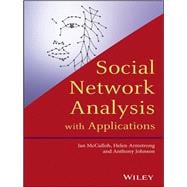
What is included with this book?
IAN McCULLOH, PhD, holds academic appointments at several institutions to include Curtin University Business School. He consults industry to increase collaboration in knowledge-intensive organizations and educates military intelligence professionals to more ethically and effectively target enemy networks. He has supported the U.S. Military with network analysis to include service in Afghanistan and Iraq.
HELEN ARMSTRONG, PhD, is an Associate Professor in the School of Information Systems at Curtin University in Perth, Australia. She has more than twenty years' experience teaching and conducting research in ICT network security, analyses of networks and systems, information systems strategy, and management and problem solving in business environments. She works closely with industry in the application of network analyses for business problem solving and risk analyses.
ANTHONY JOHNSON, PhD, is an Associate Professor in the Department of Mathematical Sciences at the United States Military Academy at West Point. He has served in a variety of positions ranging from Fiber Optic Cable Network Engineer for the White House Communications Agency to the Chief of Counter Improvised Explosive Device (CIED) Operations in Iraq where he applied linear algebra and graph theory to exploit terrorist networks.
List of Figures xi
List of Tables xv
Foreword xvii
Preface xix
Acknowledgments xxi
Introduction xxv
Part I Network Basics
Chapter 1 What is a Network? 3
1.1 Basic Network Concepts 4
1.2 Adjacency Matrices, Graphs, and Notation 4
1.3 Nodes and Links 6
1.4 Good Will Hunting Problem 9
1.5 Formal and Informal Networks 13
1.6 Summary 18
Chapter 2 Centrality Measures 29
2.1 What is “Centrality” and Why do we Study It? 29
2.2 Calculating Nodal Centrality Measures 33
2.3 Directed Networks and Centrality Measures 46
2.4 Location in the Network 46
2.5 Summary 52
Chapter 3 Graph Level Measures 69
3.1 Density 70
3.2 Diameter 71
3.3 Centralization 73
3.4 Average Centralities 77
3.5 Network Topology 78
3.6 Summary 86
Part II Social Theory
Chapter 4 Social Links 109
4.1 Individual Actors 110
4.2 Social Exchange Theory 111
4.3 Social Forces 113
4.4 Graph Structure 120
4.5 Agent Optimization Strategies in Networks 121
4.6 Hierarchy of Social Link Motivation 124
4.7 Summary
Chapter 5 Subgroup Analysis 129
5.1 Subgroups 129
5.2 Organizational Theory 130
5.3 Random Groups 133
5.4 Heuristics for Subgroup Identification 133
5.5 Analysis Methods 135
5.6 Summary 143
Chapter 6 Diffusion and Influence 149
6.1 Applications for Social Diffusion 149
6.2 Strain Theory 151
6.3 Social Context 152
6.4 Group Impacts on Diffusion 156
6.5 Network Structure and Diffusion 158
6.6 Group Influence Strategies and Bases of Power 160
6.7 Summary 165
Part III Data
Chapter 7 Meta-Networks and Relational Algebra 173
7.1 Modes of Data 174
7.2 Source, Target, Direction 174
7.3 Mulitmode Networks 176
7.4 Bridging a Meta-Network 180
7.5 Strength of Ties 182
7.6 Summary 183
Chapter 8 Sources of Data 189
8.1 Network Sampling 189
8.2 Measuring Links 191
8.3 Data Quality 195
8.4 Additional Ethnographic Data Collection Methods 196
8.5 Anonymity Issues 198
8.6 Summary 199
Part IV Organizational Risk
Chapter 9 Organizational Risk 205
9.1 What is risk? 205
9.2 Measures of Centrality and Risk 207
9.3 Other Risk Measures 216
9.4 The Right Network: Efficient Versus Learning/Adaptive 220
9.5 Network Threats and Vulnerabilities 223
9.6 Thickening a Network 226
9.7 Thinning a Network 227
9.8 Process of Organizational Risk Analysis 228
9.9 Summary of Main Points 231
Appendix A: Matrix Algebra Primer 235
Appendix B: Tables of Data and Networks 241
Appendix C: Five Points of a Graph 273
Index 281
The New copy of this book will include any supplemental materials advertised. Please check the title of the book to determine if it should include any access cards, study guides, lab manuals, CDs, etc.
The Used, Rental and eBook copies of this book are not guaranteed to include any supplemental materials. Typically, only the book itself is included. This is true even if the title states it includes any access cards, study guides, lab manuals, CDs, etc.